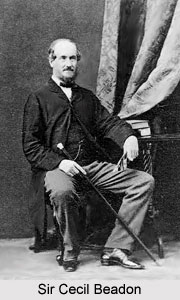 Sir Cecil Beadon KCSI was one of the most renowned Lieutenant Governors of Bengal Presidency from the year 1862 to 1866, in undivided India under the rule of the British East India Company. He also acted as a colonial administrator in British India. He was born in the year 1816 as the youngest son of Richard Beadon and the grandson of Richard Beadon, who was the bishop of Bath and Wells. His mother was the sister of William Court, 1st Baron Heytesbury. He received his education from Eton College and later studied at Shrewsbury School in Shrewsbury, Shropshire, England. Beadon also served as one of the members of the British Indian Civil Service, which was the civil service of the Government of India during the era of the rule of British Empire in India. The members of the civil service were appointed under Section XXXII of the Government of India Act, 1858 of the Parliament of the United Kingdom. After the year 1886, the Indian Civil Service was officially known as Imperial Civil Service.
Sir Cecil Beadon KCSI was one of the most renowned Lieutenant Governors of Bengal Presidency from the year 1862 to 1866, in undivided India under the rule of the British East India Company. He also acted as a colonial administrator in British India. He was born in the year 1816 as the youngest son of Richard Beadon and the grandson of Richard Beadon, who was the bishop of Bath and Wells. His mother was the sister of William Court, 1st Baron Heytesbury. He received his education from Eton College and later studied at Shrewsbury School in Shrewsbury, Shropshire, England. Beadon also served as one of the members of the British Indian Civil Service, which was the civil service of the Government of India during the era of the rule of British Empire in India. The members of the civil service were appointed under Section XXXII of the Government of India Act, 1858 of the Parliament of the United Kingdom. After the year 1886, the Indian Civil Service was officially known as Imperial Civil Service.
Career of Cecil Beadon
Cecil Beadon was appointed as a member of the Bengal civil service at the age of 18 years. The appointment was placed by the court of directors at the disposal of his uncle Lord Heytesbury, nominated as Governor General of India in 1835. Beadon went to British India in the year 1836 and was initially assigned as magistrate of Murshidabad in district offices administration. Later in 1843, he was appointed Under Secretary to the Government of Bengal. He held many positions in the revenue administration and was eventually selected by James Broun Ramsay, 1st Marquess of Dalhousie to represent the Bengal Presidency on a commission on the postal system in the year 1850. He also served as Secretary to the Government of Bengal, Secretary to the Government of India in the Home Department, Foreign Secretary and Member of the Council of the Governor General from 1860 to 1862.
Sir Cecil Beadon KCSI was appointed as the Lieutenant Governor of Bengal in the year 1862 and was preceded by Sir John Peter Grant. The Bengal Presidency originally comprised east and west Bengal and was a colonial region of the British Empire in India. The region included the territories of undivided Bengal like West Bengal, Tripura, Orissa, Meghalaya, Bihar, Assam and modern Bangladesh. Beadon was supported by 3 Governors General, Dalhousie, Canning and Hardinge, who consulted him on issues of internal administration. Cecil Beadon acted as the Home Secretary during the Great Revolt of 1857, also known as the Sepoy Mutiny. Sir Cecil Beadon KCSI served in office till the year 1866 and was succeeded by Sir William Grey.
Personal Life of Cecil Beadon
Cecil Beadon was married with Harriet in the year 1837. She was the daughter of Major R. H. Sneyd of the Bengal Cavalry. Later in 1860, he was married for a second time with Agnes, daughter of W. H. Sterndale. He died on 18 July 1880 at the age of 65 years. Sir Cecil Beadon was knighted with Knight Commander of the Most Exalted Order of the Star of India (KCSI).






































